Enhancing Construction Efficiency: The Positive Impact of Artificial Intelligence during Periods of Inflation
The ongoing challenges posed by inflation heighten the risks of an already complex environment in the construction industry, resulting in project delays, exceeding budgetary limits, and even project cancellations. For leaders within the construction sector, the appetite to accomplish more with fewer resources means going above and beyond conventional good practices; it has become an indispensable facet of survival.
In the construction industry, contractors are beginning to feel the squeeze. They operate on tight profit margins meaning when costs go up, it creates big problems, specifically on project timelines. Prices for materials and other expenses have rapidly increased in the last few years, making it hard for contractors to accurately estimate how much a project will ultimately cost. This can cause an increase in unplanned project spend , eating into profit margins, sometimes resulting in a loss. .
On top of that, supply chain is also a key issue. For example, materials might not arrive on time, uprooting the project schedule even more. Contractors take on the most risk when it comes to inflation. If they don’t estimate the costs accurately when bidding for a job, it can cause issue for projected finances, especially if they are locked into a fixed-price contract.
This uncertainty makes it tough for construction companies to get the funding they need for projects. Investors are getting more cautious, particularly when it comes to big projects with a lot of moving parts or long timelines.
The impact of time savings on the need for streamlined operations
Not taking the time to think about what could go wrong and plan for every eventuality can cause great issues if something unexpected happens. The bigger the risk, the more time required to spend figuring out how to deal with it and how much it might cost you. And in today’s economy where prices keep going up, it’s unlikely you’ll be able to make up for any losses if something goes wrong during construction. This becomes particularly hard as most site and risk assessments in the construction industry today are still done on paper.
Why optimization can’t happen in tandem with outdated processes
When operational assessments are conducted on paper (or digital equivalents), it exacerbates the challenges and risks associated with construction projects. Using a paper-based system introduces several drawbacks that hinder efficiency, accuracy, and the overall success of the assessment process:
- Limited Accessibility and Collaboration:
- Paper documents are often physically stored and can be challenging to access remotely. This limitation hampers collaboration among team members who may be working from different locations.
- Data Silos and Disorganization:
- Paper assessments contribute to data silos and disorganization. Retrieving specific information or tracking changes becomes cumbersome, leading to potential oversights and miscommunication.
- Inefficiency in Data Processing:
- Manual data entry on paper is time-consuming and prone to errors. Analyzing and processing information takes longer, delaying the identification and management of risks.
- Lack of Real-time Updates:
- Paper assessments do not allow for real-time updates. Changes or developments in the construction site conditions may not be promptly recorded or communicated, leading to outdated risk assessments.
- Increased Vulnerability to Loss or Damage:
- Paper documents are susceptible to physical damage, loss, or misplacement. Critical risk assessment information may be compromised, impacting the accuracy and completeness of the assessment.
- Limited Analytical Capabilities:
- Paper assessments lack the analytical capabilities that modern digital tools provide. AI-powered video analysis, as mentioned in the original context, enables quicker and more sophisticated hazard detection, which is not feasible with traditional paper methods.
- Reduced Accountability and Audit Trail:
- Paper assessments make it challenging to establish a clear audit trail and assign accountability for specific actions. This lack of traceability can be crucial in understanding the sequence of events and decision-making processes in case of disputes or issues.
- Environmental Impact:
- Utilizing paper-based assessments contributes to environmental concerns due to the consumption of resources in paper production and the potential for increased waste.
How to navigate these challenges through Artificial Intelligence
FYLD’s innovative AI-driven video analysis system alleviates many of these challenges by swiftly identifying and managing risks. This cutting-edge technology eliminates the need for cumbersome paperwork, fostering a safer and more productive environment on construction sites. Below outlines how FYLD is enhancing efficiency within the construction industry:
- Accelerated Risk Assessments: AI-powered video analysis swiftly detects potential hazards, empowering workers to promptly address risks and avert costly delays or accidents.
- Streamlined Communication: A centralized platform interconnects all stakeholders along a unified digital thread, thereby diminishing miscommunication, rework, and lost productivity.
- Paperless Forms and Checklists: The elimination of manual data entry, paper-related expenses, and time wastage allows for an unwavering focus on task completion rather than form completion.
FYLD works with, and partners with industry leaders such as Granite and Ferrovial, who are not merely weathering the challenges but actively redefining operations for a more efficient, secure, and sustainable future.
Ferrovial’s experience attests to the profound impact. Hindered by an abundance of paperwork and outdated processes, its team struggled to maintain pace. FYLD’s robust digital platform elevated productivity, saving the average worker 10 minutes daily previously lost to suboptimal workflows. This translated into recovered hours each week, increasing productivity by 8%. Through their collaboration with FYLD, Ferrovial is successfully concluding more projects and fortifying its financial standing. FYLD is contributing to revenue earning assets being completed faster.

FYLD is a strategic partner in fortifying resilience against cost increases, supply chain disruptions, and labor shortages. By means of process optimization, resource allocation, and productivity augmentation, FYLD empowers construction enterprises to navigate prevailing challenges and attain success amidst the evolving landscape.
Interested in how FYLD can help you overcome current challenges across construction? Request a free demo today.






